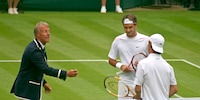
News + Trends
Wimbledon replaces linesmen with computers
by Kim Muntinga

Wimbledon has abolished human line judges. However, the AI solution comes under fire after an incident in the match between Pavlyuchenkova and Kartal and causes frustration.
Human line judges are a thing of the past at Wimbledon as of this year. The world's most traditional tennis tournament now relies entirely on the automated system «Electronic Line Calling» (ELC). I already told you about this last year.
In a nutshell: The technology is based on the tried-and-tested Hawk-Eye platform and replaces the linesmen with a network of 18 high-speed cameras per court. The system recognises ball positions and foot faults in real time. Decisions are announced via loudspeakers with a synthesised voice.
What sounds efficient on paper is a source of debate on the pitch. Because the AI system is not flawless.
In the round of 16 between Anastasia Pavlyuchenkova of Russia and Sonay Kartal of Great Britain, there was a momentous slip-up. At 4:4 in the first set with Pavlyuchenkova having the advantage, a ball from Kartal landed clearly out of bounds. But the system did not react. Instead, a confusing «stop, stop» sounded from the loudspeakers shortly afterwards. The point was cancelled and replayed, even though Pavlyuchenkova should have won it. Kartal took the game 5:4, but the Russian ultimately won the first set in a tie-break and also won the second 6:4 to take the match.

As the Guardian reports, the reason for the error was not a technical failure of the AI, but an operator error: an operator had accidentally deactivated the ELC system on Pavlyuchenkova's side. The tournament organisers confirmed this in an official statement to Sky Sports.
Wimbledon chief executive Sally Bolton also faced the media. In a press conference focused almost exclusively on the ELC, she emphasised several times that it had been a «purely human error». The protocols have since been adapted to prevent similar incidents in the future. Apart from this incident, Bolton said, the system was working reliably.
The incident has sparked a debate on how to deal with technology failures in elite sport. The Guardian emphasises that the case highlights the need for contingency plans - such as the ability to fall back on video replays or refereeing decisions in the event of system failures. There are currently no plans for this at Wimbledon.
Instead of being celebrated as progress, the new system at Wimbledon was under pressure from the outset and even before this incident: the All England Lawn Tennis Club (AELTC) was already forced to defend the introduction of AI-supported line judge technology in the first week of the tournament. Critical voices and media debates dominated the headlines and confidence in the technology began to waver.

Especially tricky: The two top British players Jack Draper and Emma Raducanu clearly criticised the system after their defeats. Both were convinced that the wrong decisions had been made in their favour. Raducanu said after her elimination in the third round: «It's disappointing that the decisions in this tournament can be so wrong. In my other matches, there were also some that were very wrong.»
The mood towards the ELC system was originally positive. Since its introduction on hard courts, many professionals have praised the greater accuracy compared to human linesmen. However, after several controversial scenes in the first week of Wimbledon on the hallowed London turf, players and coaches became increasingly sceptical. Both publicly and behind the scenes, the reliability of the system was called into question.
Whether confidence in the technology can be restored by the end of the tournament remains to be seen.
My interests are varied, I just like to enjoy life. Always on the lookout for news about darts, gaming, films and series.
From the latest iPhone to the return of 80s fashion. The editorial team will help you make sense of it all.
Show all